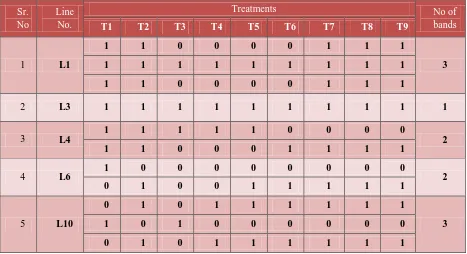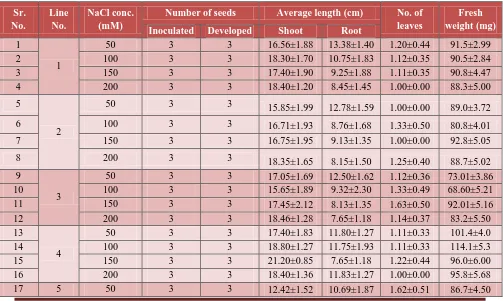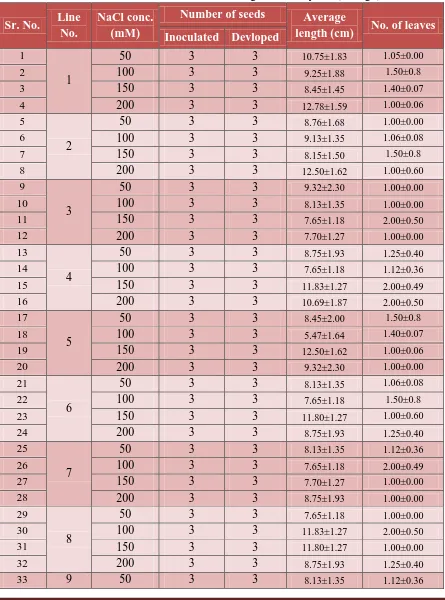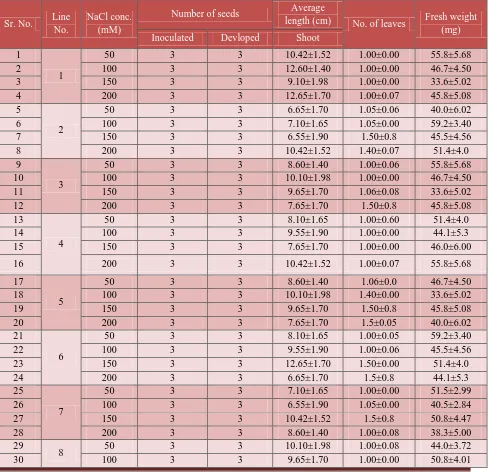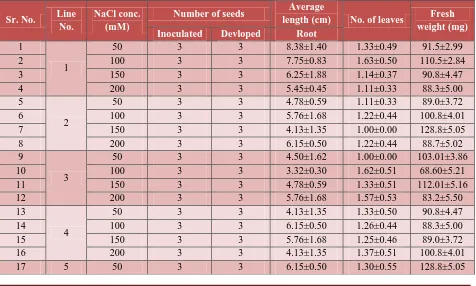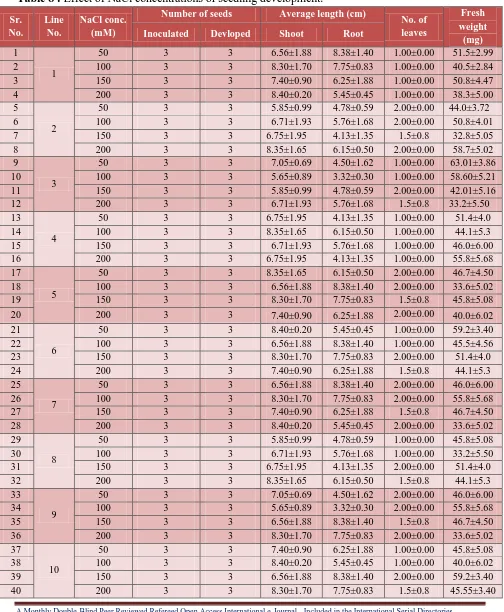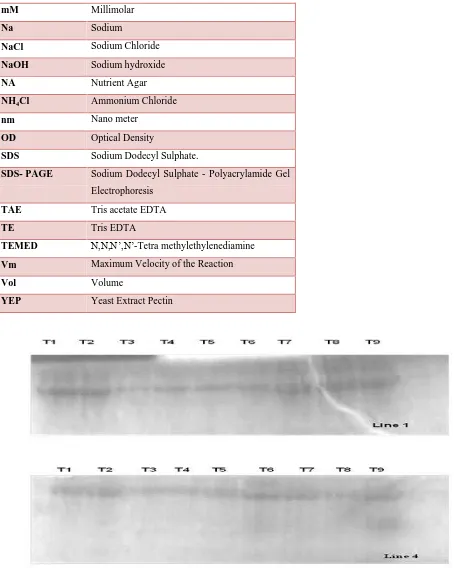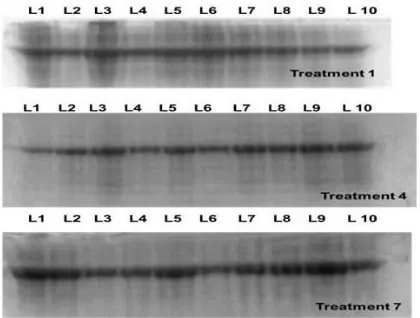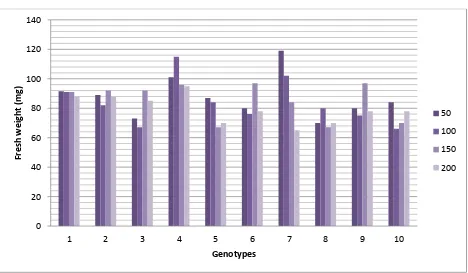A Monthly Double-Blind Peer Reviewed Refereed Open Access International e-Journal - Included in the International Serial Directories
International Research Journal of Natural and Applied Sciences (IRJNAS)
Website: www.aarf.asia. Email: editoraarf@gmail.com , editor@aarf.asia Page 8
ANALYSIS OF PROTEIN CONTENT AND IN VITRO PHENOTYPIC
DATA IN SORGHUM LINE FOR SALT TOLERANCE
Mayuri C. Rathod1, Ruchi A. Patel2 and D.A.Dhale3* 1,2
Department of Biotechnology, Veer Narmad South Gujarat University, Surat-395007, Gujarat, India
3
PG-Department of Botany, SSVPS’s, L.K.Dr.P.R.Ghogrey Science College, Dhule-424005 (M.S., India)
ABSTRACT
The capability of crops to grow on saline soils varies among species and depends on the concentration of salts present in the rootzone and on various environmental and cultural conditions. Information on the relative tolerance of different crops is essential to the successful management of salt-affected agricultural lands and waters. Results from over 50 years of research have produced salt tolerance data that relate yield reductions of over 90 different crops to soil salinity. These data are presented in tabular form and give threshold salinity values and percent yield reductions expected at salinities exceeding the threshold. The recommended procedure to acquire reliable data, the yield response function used to quantify salt tolerance data, and factors to consider when evaluating or using these data are also described.
KEYWORDS
:
Cereal crop, In vitro, Phenotype, Rootzone, Sorghum, soil salinity INTRODUCTIONSorghum [Sorghum bicolor (L.) Moench ] is the fifth most important cereal crop of the world and is a major source of food, feed and fodder in the semi-arid tropics (SAT). It is the third most important staple food crop after rice (Oryza sativa) and wheat (Triticum aestivum) for millions of people in India. The grain molds, shoot fly and prolonged dry spells are main reasons for low productivity in India. Of all the soil mineral stresses or chemical toxicities, acidity, and associated Al3+ toxicity and
salinity are probably the most important constraints to sorghum productivity in tropical
environments. Saline and sodic soils cause mineral stresses on approximately 0.9 billion hectors
of land (Gourley et al.,1997). In addition, the problematic soils that include saline soils which
constitute 15% (approx.) of total cultivable area in India, reduce crop productivity leading to
A Monthly Double-Blind Peer Reviewed Refereed Open Access International e-Journal - Included in the International Serial Directories
International Research Journal of Natural and Applied Sciences (IRJNAS)
Website: www.aarf.asia. Email: editoraarf@gmail.com , editor@aarf.asia Page 9
The increased demand for sorghum, especially for feed uses in SAT regions (Kleih et al.,
2000) imposes extension of sorghum cultivation in saline soils. Development of cultivars tolerant
to soil salinity along with appropriate management practices is required for enhanced production
under saline conditions (Ramesh et al., 2005). Salinity causes reduction in germination (Igartua
et al.,1994), growth (Maiti et al.,1994) and yields of sorghum (Macharia et al.,1994) and
modifies the physiological and biochemical processes of the plant (Dubey, 1994). Salinity causes
more serious damage in the seedling emergence stage than in any other stage in sorghum
(Macharia et al.,1994). Though sorghum is known to be relatively more tolerant to soil salinity
than maize (Zea mays) (Igartua et al.,1994; Krishnamurthy et al.,2007), genetic enhancement of
sorghum for salinity tolerance would further increase sorghum productivity in such soils.
The agricultural potentiality in the salinized areas is directly associated with production of salt
resistant cultivars. The intensive crop yield in these salinized areas helps to resolve a great
livestock regional problem of forage crop shortage, mainly in dry period of the year. According
to the association (Grupo, 2005) in 2004 the Brazilian sorghum area was 1,269,000 hector.
According to (Ahloowalia et al., 2004), there were 2,250 new mutants registered by gamma rays
from 163 botanical species, from 62 countries. A new genetic material is considered when a
change in basic genotype occurs (IAEA, 1977). Bretaudeau and Traore (1990) declared that
sorghum mutation induction by gamma rays doses of 200 to 300 Gy presented environmental
stress viability tolerance. It is important to define which gamma ray dose is to be utilized to
promote favorable changes. Moreover, the confirmation of genetic changes by gamma ray use is
possible with microsatellite techniques (Ferreira and Grattapaglia, 1998). In this work sorghum
plants were evaluated for high salinity tolerance through electrical conductivity (EC) levels and
gamma ray doses. About 7% of the world’s total land area is affected by salt, as is a similar
percentage of its arable land (Ghassemi et al., 1995).
Salinity is often accompanied by other soil properties, such as sodicity and alkalinity, which
exert their own specific effects on plant growth. Salinity and water logging co-exist in the lower
reaches of several river basins throughout the world, affecting agricultural production and the
A Monthly Double-Blind Peer Reviewed Refereed Open Access International e-Journal - Included in the International Serial Directories
International Research Journal of Natural and Applied Sciences (IRJNAS)
Website: www.aarf.asia. Email: editoraarf@gmail.com , editor@aarf.asia Page 10
overcome salinity and water logging problems by consist of engineering solutions such as
installation of a drainage system to manage the drainage effluent generated by irrigated
agriculture. This is a long term strategy; however drainage installation is expensive. The areas
under salt-affected and waterlogged soils are expanding because of inappropriate on-farm water
and soil management. Selection and cultivation of high-yielding salt-tolerant varieties of
different crops is a potential interim strategy to fulfill the needs of the communities relying on
these soils for their livelihoods (Ayers and Westcot, 1989). Many crops show intraspecific
variation in response to salinity. Sorghum is moderately salt-tolerant. Generally, substantial
genotypic differences exist among sorghum cultivars in response to salinity stress (Sunseri et al.,
2002; Netondo et al., 2004).
Breeding programs for new varieties of sweet sorghum suited to semi arid tropics, temperate
areas with rainy summer, Mediterranean areas with dry summer and soil salinity, are under
development (Cosentino, 1996). Sorghum is characterized as moderately tolerant to salinity
(Almodares and Sharif, 2005; Almodares and Sharif, 2007). Salinity reduces sorghum growth
and biomass production . Salinity greatly reduced sorghum growth and this effect was more
pronounced at 250 mM than at 125 mM NaCI (Ibrahim, 2004). However it was reported that
sorghum growth was significantly reduced at all salinity levels from 50 to 150 mM (El-Sayed et
al., 1994). Imposition of salt stress resulted in decreases in the percentage of seeds germinated
(Almodares et al., 2007), although the strongest decline in germination occurred at the highest
salt concentration. Nevertheless, the development of high-yielding salinity tolerant sorghums is
the best option to increase the productivity in soils (Igartua et al.,1994). Similarly, Gill et
al.,(2003) observed a great reduction in germination rate due to salt stress, in sorghum seeds at
37°C in NaCl.
The present work has been undertaken to standardize the in vitro screening protocols for
A Monthly Double-Blind Peer Reviewed Refereed Open Access International e-Journal - Included in the International Serial Directories
International Research Journal of Natural and Applied Sciences (IRJNAS)
Website: www.aarf.asia. Email: editoraarf@gmail.com , editor@aarf.asia Page 11
MATERIALS AND METHODS
Seed material: Ten lines of sorghum having different tolerance to salt were used in the study. The material has been procured from the sorghum research centre, Athwalines, Surat (Gujarat State,
India).
Seed Germination: Seeds were placed on Petri plates lined with germination paper soaked with water. Petri plates were incubated at room temperature, for 7-8 days. The papers were wetted
with 1 ml water, if required. 10-day-old seedlings were used for DNA extraction.
Protein extraction: Shoot of single seedling was grinded in pestle and mortar with 1000 µl of extraction buffer (recipe in the Annexure). Grind the tissue completely. Transfer the extract in
1.5 ml centrifuge tube. Wash the pestle and mortar with another 1000 µl of extraction buffer.
Transfer the same to the previous tube. Incubate tubes in refrigerator overnight. After this
centrifuge the content at 10000 rpm for 10 min in a refrigerated centrifuge.
SDS-PAGE for proteins: Samples of the same extracts as analysed for total proteins were denaturated according to Laemmli (1970) and O’Farrel (1975). The two glass plates were
cleaned thoroughly with 70% alcohol. The spacers and gasket were also cleaned properly. The
bigger plant was kept at the bottom on which spacers (1.5 mm) placed at two longitudinal edges.
On top of spacers, another glass plate placed. This sandwich placed carefully in casting stand. At
first 3 ml of molten agar (1% agar in water) was poured in between the space of two glass plates.
This was done to avoid leakage from the base. It was left undisturbed for 30 min. After this
leakage checked using water. If leakage is there more agar solution overlaid. Once the leakage
stops, water present in between glass plate sandwich was removed by carefully tilting the
assembly. 12.5% separating gel solution was prepared using acrylamide, bis-acrylamide, APS
and TEMED. 30 ml of this solution was poured in between two glass plates. It was overlaid with
1 ml of DDW. The assembly was left undisturbed for 30-45 min to allow polymerization of gel.
Once polymerized, overlaid water was removed from the assembly and 10 ml of stacking gel
solution was added. The comb was also placed in this, and left undisturbed till gel formation.
The comb was removed carefully without damaging the well. The wells were washed with the
tank buffer to remove all salt crystals. After this the gel sandwich was removed from casting
A Monthly Double-Blind Peer Reviewed Refereed Open Access International e-Journal - Included in the International Serial Directories
International Research Journal of Natural and Applied Sciences (IRJNAS)
Website: www.aarf.asia. Email: editoraarf@gmail.com , editor@aarf.asia Page 12
samples were loaded in each well. The gel was run at 175V till the samples reach the base of
stacking gel and then it was increased to 200V till the bromophenol blue reaches the end of
plate. Gel was then removed and processed for staining. Staining of gels was done with
commasie blue.
Comassie Blue Staining: Gel was rinsed briefly with water. Gel was incubated in 0.1% comassie stain for 1 h or overnight on shaker for staining. Stain was collected back in the stock
bottle and was distained using distain solution. This step was done overnight or for longer
duration, till the background becomes clear.
Recording of data: Data of gels were recorded as the presence and absence of a band in a 0,1 format.
In vitro screening experiments: To assess the role of an osmoticum agent in the growth and
development of sorghum following experiments were undertaken. For all experiments, different
concentrations of NaCl (Sodium Chloride, MW 50 mM, 100 mM, 150 mM, 200mM) were used
as stress inducing agent. It was added to the medium prior to autoclaving and its role in various
morphogenic processes was ascertained. All experiments were conducted employing plant tissue
culture methods.
Media preparation: There are various formulations available for culture media; we have used the most commonly used one that is MS medium (Murashige and Skoog, 1962). Four stocks are
prepared: macronutrient stock, micronutrient stock, organic stock and iron chelate stock. The
concentration of stocks varied with laboratory to laboratory (Table 1). All the stock solution stored
at low temperatures.
Table 1: Composition of MS medium
Components Amount (mg/l)
Stock A - Micro salts
Ammonium nitrate 1650
Potassium nitrate 1900
Calcium chloride 440
Magnesium sulphate 370
Potassium dihydrogen orthophosphate 170
Stock B - Micro nutrient
Zinc sulphate 8.6
A Monthly Double-Blind Peer Reviewed Refereed Open Access International e-Journal - Included in the International Serial Directories
International Research Journal of Natural and Applied Sciences (IRJNAS)
Website: www.aarf.asia. Email: editoraarf@gmail.com , editor@aarf.asia Page 13
Sodium molybdate 0.25
Cobalt chloride 25
Magnesium sulphate 0.025
Potassium iodide 0.025
Copper sulphate 0.025
Stock C - Iron chelate
Ferrous sulphate 27.8
Di sodium EDTA 37.3
Stock D – Vitamine
Thiamine HCL 0.5
Pyridoxine HCl 0.5
Niacin 0.5
Meso - inositol (dissolve in NaOH) 100
Preparation of stock: Four stock solutions were prepared. For each stock, the components listed above were added initially in a small volume of water. Once all components were dissolved
separately, they were mixed and final volume was made up as per the requirement. Care taken to
ensure proper dissolving of the individual components. After preparing stocks, they were stored
in stock bottles in refrigerator. Stock C stored in brown bottles to prevent its oxidation.
Preparation of media: For preparing a medium appropriate volume of stock was taken. They were added in the beaker having half volume of water initially. After mixing all stock, desired
amount of sucrose was added at the rate 3g for 100 ml medium. The solution was kept on
magnetic stirrer to ensure complete solubilisation. Antifungal solution was added to medium
200µl for 1 of the medium. Different concentrations of NaCl (MW - 58.5 mol) were added to
the medium. Desired amount of NaCl was added to the medium like 50 mM, 100 mM, 150 mM,
200mM per 100 ml medium 50 mM, 100 mM, 150 mM, 200mM. After this, final volume was
made using water. pH of the medium was adjusted to 5.8 using 1N NaOH/1N HCl. After this, the
medium was dispensed in jam jars at the rate 100 ml/ jar. To each jar 0.9 g of agar at the rate of
0.9% was added. The medium was then autoclaved for sterilization. It was done at 121oC at 105
kPa for 15 minutes. The medium was cooled and swirled the solution gently as it cools. When
sufficiently cool, the medium was dispensed into labeled, sterile containers using good aseptic
conditions.
A Monthly Double-Blind Peer Reviewed Refereed Open Access International e-Journal - Included in the International Serial Directories
International Research Journal of Natural and Applied Sciences (IRJNAS)
Website: www.aarf.asia. Email: editoraarf@gmail.com , editor@aarf.asia Page 14
solution was added to it in such a way that seeds are immersed in the solution. They were kept
on rotator shaker for 10 min. Sterilizing solution was decanted from seeds and seeds were
washed with sterile distilled water 3-4 times. Seeds left in water for 1-2 hours, prior to
inoculation.
Seed Inoculation: Seeds were either inoculated on Petri plates or jam jars as per the experiment. Experimental design: An experiment was conducted using 10 genotypes of sorghum and for each experiment 3 seeds were used per experiment. All experiments were repeated at least once
maintaining the same number of seeds.
Sub-culturing of explants into a new medium: Explants were transferred to fresh medium after 15 days to same or different media as per requirement.
Incubation of cultures: All cultures were maintained in culture rooms maintained at 25 ± 2ºC with a relative humidity of 80% and photoperiod of 16/8 hours.
Maintaining the cultures: Daily cultures were checked for contamination. All contaminated cultures were removed from culture rooms and healthy explants were rescued from the
contaminated medium. In Petri plates, water gets condensed due to transpiration through stomata;
this excess water was removed from plate lids on alternate days.
Seed germination experiment: Seeds of different ten lines of sorghum were surface sterilized in as per above protocol. MS medium with different concentrations of NaCl was heated and
dispensed in jam jars. Three compartments were made in each jar and in each sector seed (3) of
individual line were placed. Jars were incubated in the incubation room and were observed daily.
The experiment was terminated after 15 days and then the root length, shoot length, fresh weight
of seedling as well as number of leaves were recorded.
Shoot regeneration experiment: Seeds (10) per line surface sterilized as above were inoculated in jars containing MS basal medium. Seeds were incubated for 4-5 days, until the emergence of
the plumule and after this were used as a source of explants for further experiment. MS medium
containing different concentrations of NaCl (50 mM, 100 mM, 150 mM, 200mM)was melted
and were dispensed in a jam jar. The medium was fortified with 1 mg/l BA in all cases. Jam jars
were incubated in the incubation room and were observed daily. The experiment was terminated
A Monthly Double-Blind Peer Reviewed Refereed Open Access International e-Journal - Included in the International Serial Directories
International Research Journal of Natural and Applied Sciences (IRJNAS)
Website: www.aarf.asia. Email: editoraarf@gmail.com , editor@aarf.asia Page 15
recorded. The experiment was repeated twice maintaining the same number of seeds. In addition
to BA, zeatin (0.2 mg/l) was also supplemented to the MS medium having different
concentrations of NaCl. For this experiment too, all above mentioned parameters were recorded.
Root development experiment: Seeds (10) per line were taken and treated as above seed treatment then inoculated in jars containing MS medium. 2-week old seedlings were used as a
source of explants for further experiment. From seedlings, roots were removed and the left over
seedling was inoculated on the half strength MS medium containing different concentrations of
NaCl (50 mM, 100 mM, 150 mM, 200mM). All media were fortified with 1 mg/l IBA. The
experiment was terminated after 15 days and then the root length, fresh weight of seedling and
number of leaves was recorded.
Seedling development experiment: Seeds of ten lines of rice were placed in Petri plates lined with germination paper. The paper was wetted with water. Plates were incubated at the room
temperature and were observed daily. 10-day-old seedlings were transferred in Phytajar along
with a filter paper bridge. Two seedlings were placed on each bridge and Hoagland medium was
used during further experiments. 25 ml of medium as such or supplemented with different
concentrations of NaCl (50 mM, 100 mM, 150 mM, 200mM) was added to each phytajar. The
medium of each phytajar was changed after 3-4 days. The experiment terminated after one week
and all growth parameters were recorded.
Analyses of data: All observations were computed in MS-Excel. They were represented as mean ± standard error.
RESULTS AND DISCUSIONS
SDS Data analysis: Total protein was extracted from seedlings of sorghum for all the treatments for all ten genotypes. Denatured PAGE analyses were carried out for the samples. It was
observed that the treatments had a profound effect on the growth of seedling and it was evident
through the protein profiling also. We have obtained different banding patterns, which indicate
the appearance of new proteins as well as disappearance of existing ones. Although in SDS
PAGE, each protein band represents a group of proteins of similar molecular weight as we are
not going for any specific protein as such. At this moment of time, we are mainly emphasizing
A Monthly Double-Blind Peer Reviewed Refereed Open Access International e-Journal - Included in the International Serial Directories
International Research Journal of Natural and Applied Sciences (IRJNAS)
Website: www.aarf.asia. Email: editoraarf@gmail.com , editor@aarf.asia Page 16
banding patterns (Figure 1; Table 2).
Table 2: Effect of altered NaCl content of MS medium, after 10 days of incubation on a single line, based on the protein banding pattern.
Sr. No
Line No.
Treatments No of
bands
T1 T2 T3 T4 T5 T6 T7 T8 T9
1 L1
1 1 0 0 0 0 1 1 1
3
1 1 1 1 1 1 1 1 1
1 1 0 0 0 0 1 1 1
2 L3 1 1 1 1 1 1 1 1 1 1
3 L4
1 1 1 1 1 0 0 0 0
2
1 1 0 0 0 1 1 1 1
4 L6
1 0 0 0 0 0 0 0 0
2
0 1 0 0 1 1 1 1 1
5 L10
0 1 0 1 1 1 1 1 1
3
1 0 1 0 0 0 0 0 0
0 1 0 1 1 1 1 1 1
[image:9.612.72.539.166.420.2]At morphological level: Three different morphogenic modes, viz., Seed germination, shoot regeneration and root development were evaluated in the presence of salt stress created by using different concentrations (50 mM, 100 mM, 150 mM, 200mM) of NaCl (Table 3; Figure 2).
Table 3: Effect of different treatment on sorghum lines after 10 days of incubation based on the protein banding pattern.
Sr. No.
Treatment No.
Genotypes No. of
bands
1 2 3 4 5 6 7 8 9 10
1 T1
1 1 1 1 1 1 1 1 1 1
4
1 1 1 1 1 1 1 1 1 1
1 1 1 1 1 1 1 1 1 1
1 0 1 0 1 1 1 0 0 0
2 T3 1 1 1 1 1 1 1 1 1 1 1
3 T4
0 1 1 0 0 0 1 1 1 1
8
0 1 1 0 1 0 1 1 1 1
1 1 1 1 1 1 1 1 1 1
0 1 1 0 1 0 1 1 1 1
A Monthly Double-Blind Peer Reviewed Refereed Open Access International e-Journal - Included in the International Serial Directories
International Research Journal of Natural and Applied Sciences (IRJNAS)
Website: www.aarf.asia. Email: editoraarf@gmail.com , editor@aarf.asia Page 17
0 1 1 0 1 0 1 1 1 1
1 0 1 0 1 0 1 1 1 1
0 1 1 0 1 0 1 1 1 0
4 T7
1 1 1 1 1 1 1 1 1 1
7
1 1 1 1 1 1 1 1 1 1
1 1 1 1 1 1 1 1 1 1
1 1 1 1 1 1 1 1 1 1
1 1 0 0 1 0 1 1 1 0
1 1 1 1 1 0 1 1 1 0
1 1 1 1 1 0 1 1 1 0
Seed germination: Dehusked seeds were inoculated on MS basal medium supplemented with aforesaid concentrations of NaCl. Seeds started to germinate within 4-5 days of inoculation.
Concentrations had a profound affect on seed germination. With the increase in concentrations
of NaCl elongation of roots was more comparable to the shoot in almost all genotypes (Table 4;
Figure 3). Number of leaves although did not differ much however, the expansion of leaves. The
fresh weight of seedling decreased with increase in NaCl. Effect of NaCl was more pronounced in
[image:10.612.75.542.95.231.2]some genotypes compared to others.
Table 4 : Effect of NaCl concentrations on seed Germination. Sr. No. Line No. NaCl conc. (mM)
Number of seeds Average length (cm) No. of leaves
Fresh weight (mg) Inoculated Developed Shoot Root
1
1
50 3 3 16.56±1.88 13.38±1.40 1.20±0.44 91.5±2.99
2 100 3 3 18.30±1.70 10.75±1.83 1.12±0.35 90.5±2.84
3 150 3 3 17.40±1.90 9.25±1.88 1.11±0.35 90.8±4.47
4 200 3 3 18.40±1.20 8.45±1.45 1.00±0.00 88.3±5.00
5
2
50 3 3 15.85±1.99 12.78±1.59 1.00±0.00 89.0±3.72
6 100 3 3 16.71±1.93 8.76±1.68 1.33±0.50 80.8±4.01
7 150 3 3 16.75±1.95 9.13±1.35 1.00±0.00 92.8±5.05
8 200 3 3 18.35±1.65 8.15±1.50 1.25±0.40 88.7±5.02
9
3
50 3 3 17.05±1.69 12.50±1.62 1.12±0.36 73.01±3.86
10 100 3 3 15.65±1.89 9.32±2.30 1.33±0.49 68.60±5.21
11 150 3 3 17.45±2.12 8.13±1.35 1.63±0.50 92.01±5.16
12 200 3 3 18.46±1.28 7.65±1.18 1.14±0.37 83.2±5.50
13
4
50 3 3 17.40±1.83 11.80±1.27 1.11±0.33 101.4±4.0
14 100 3 3 18.80±1.27 11.75±1.93 1.11±0.33 114.1±5.3
15 150 3 3 21.20±0.85 7.65±1.18 1.22±0.44 96.0±6.00
16 200 3 3 18.40±1.36 11.83±1.27 1.00±0.00 95.8±5.68
[image:10.612.56.559.405.706.2]A Monthly Double-Blind Peer Reviewed Refereed Open Access International e-Journal - Included in the International Serial Directories
International Research Journal of Natural and Applied Sciences (IRJNAS)
Website: www.aarf.asia. Email: editoraarf@gmail.com , editor@aarf.asia Page 18
18 100 3 3 12.60±1.40 8.45±2.00 1.33±0.51 83.6±5.02
19 150 3 3 10.10±1.98 5.47±1.64 1.57±0.53 65.8±5.08
20 200 3 3 12.65±1.70 7.46±1.31 1.33±0.50 70.0±6.02
21
6
50 3 3 11.65±1.70 10.03±1.29 1.26±0.44 79.2±3.40
22 100 3 3 11.10±1.65 7.65±1.32 1.25±0.46 75.5±4.56
23 150 3 3 12.55±1.90 7.23±1.33 1.37±0.51 96.3±5.23
24 200 3 3 17.02±1.64 8.93±1.65 1.30±0.55 78.0±5.02
25
7
50 3 3 15.24±1.40 13.32±1.35 1.70±0.44 118.8±4.9
26 100 3 3 15.25±2.04 9.13±1.53 1.77±0.44 102±4.47
27 150 3 3 17.45±2.12 12.50±1.62 1.22±0.44 83.6±5.02
28 200 3 3 18.46±1.28 9.32±2.30 1.00±0.00 65.8±5.08
29
8
50 3 3 17.40±1.83 8.13±1.35 1.62±0.51 70.0±6.02
30 100 3 3 18.80±1.27 7.65±1.18 1.33±0.51 79.2±3.40
31 150 3 3 21.20±0.85 11.80±1.27 1.57±0.53 65.8±5.08
32 200 3 3 12.65±1.70 11.75±1.93 1.33±0.50 70.0±6.02
33
9
50 3 3 11.65±1.70 7.65±1.18 1.57±0.53 79.2±3.40
34 100 3 3 11.10±1.65 10.69±1.87 1.33±0.50 75.5±4.56
35 150 3 3 12.55±1.90 8.45±2.00 1.26±0.44 96.3±5.23
36 200 3 3 17.02±1.64 5.47±1.64 1.25±0.46 78.0±5.02
37
10
50 3 3 15.24±1.40 7.46±1.31 1.37±0.51 83.6±5.02
38 100 3 3 15.25±2.04 10.03±1.29 1.30±0.55 65.8±5.08
39 150 3 3 11.10±1.65 7.65±1.32 1.70±0.44 70.0±6.02
40 200 3 3 12.55±1.90 7.23±1.33 1.26±0.44 79.2±3.40
Shoot regeneration: To assess the affect of NaCl on shoot regeneration, pre-germinated seeds were used. The shoot meristem was excised off and the trimmed seeds were placed on MS
medium containing cytokinins (BA or Zeatin) supplemented with different concentrations of
NaCl. Average shoot length was affected by the change in concentration of NaCl. With the
increase in concentration of NaCl, shoot length reduced gradually (Table 5; Figure 5). In
addition to this, the leaf area also changed with increased concentration of NaCl. Some
genotypes exhibited a greater reduction in soot length compared to others.
To compare the effect of cytokinins on shoot regeneration, two cytokinins, viz., BA and
zeatin were used. It was observed that shoots developed in presence of zeatin were much
healthier (Figure 6B) and stronger compared to those developed for BA supplemented medium
(Figure 6A,7; Table 6). Among these two cytokinins, zeatin exhibited a more consistency in
A Monthly Double-Blind Peer Reviewed Refereed Open Access International e-Journal - Included in the International Serial Directories
International Research Journal of Natural and Applied Sciences (IRJNAS)
[image:12.612.85.530.105.705.2]Website: www.aarf.asia. Email: editoraarf@gmail.com , editor@aarf.asia Page 19
Table 5 : Effect of NaCl concentrations on shoot regeneration by BA (1.0mg/l) .
Sr. No. Line No.
NaCl conc. (mM)
Number of seeds Average
length (cm) No. of leaves Inoculated Devloped
1
1
50 3 3 10.75±1.83 1.05±0.00
2 100 3 3 9.25±1.88 1.50±0.8
3 150 3 3 8.45±1.45 1.40±0.07
4 200 3 3 12.78±1.59 1.00±0.06
5
2
50 3 3 8.76±1.68 1.00±0.00
6 100 3 3 9.13±1.35 1.06±0.08
7 150 3 3 8.15±1.50 1.50±0.8
8 200 3 3 12.50±1.62 1.00±0.60
9
3
50 3 3 9.32±2.30 1.00±0.00
10 100 3 3 8.13±1.35 1.00±0.00
11 150 3 3 7.65±1.18 2.00±0.50
12 200 3 3 7.70±1.27 1.00±0.00
13
4
50 3 3 8.75±1.93 1.25±0.40
14 100 3 3 7.65±1.18 1.12±0.36
15 150 3 3 11.83±1.27 2.00±0.49
16 200 3 3 10.69±1.87 2.00±0.50
17
5
50 3 3 8.45±2.00 1.50±0.8
18 100 3 3 5.47±1.64 1.40±0.07
19 150 3 3 12.50±1.62 1.00±0.06
20 200 3 3 9.32±2.30 1.00±0.00
21
6
50 3 3 8.13±1.35 1.06±0.08
22 100 3 3 7.65±1.18 1.50±0.8
23 150 3 3 11.80±1.27 1.00±0.60
24 200 3 3 8.75±1.93 1.25±0.40
25
7
50 3 3 8.13±1.35 1.12±0.36
26 100 3 3 7.65±1.18 2.00±0.49
27 150 3 3 7.70±1.27 1.00±0.00
28 200 3 3 8.75±1.93 1.00±0.00
29
8
50 3 3 7.65±1.18 1.00±0.00
30 100 3 3 11.83±1.27 2.00±0.50
31 150 3 3 11.80±1.27 1.00±0.00
32 200 3 3 8.75±1.93 1.25±0.40
A Monthly Double-Blind Peer Reviewed Refereed Open Access International e-Journal - Included in the International Serial Directories
International Research Journal of Natural and Applied Sciences (IRJNAS)
Website: www.aarf.asia. Email: editoraarf@gmail.com , editor@aarf.asia Page 20
34 100 3 3 7.65±1.18 2.00±0.49
35 150 3 3 7.70±1.27 1.00±0.00
36 200 3 3 8.75±1.93 1.00±0.00
37
10
50 3 3 7.65±1.18 2.00±0.50
38 100 3 3 11.83±1.27 1.00±0.00
39 150 3 3 7.65±1.18 1.25±0.40
[image:13.612.71.560.235.707.2]40 200 3 3 7.70±1.27 1.00±0.00
Table 6: Effect of NaCl concentrations on shoot regeneration by Zeatin (0.2 mg/l).
Sr. No. Line No.
NaCl conc. (mM)
Number of seeds Average
length (cm) No. of leaves Fresh weight (mg) Inoculated Devloped Shoot
1
1
50 3 3 10.42±1.52 1.00±0.00 55.8±5.68
2 100 3 3 12.60±1.40 1.00±0.00 46.7±4.50
3 150 3 3 9.10±1.98 1.00±0.00 33.6±5.02
4 200 3 3 12.65±1.70 1.00±0.07 45.8±5.08
5
2
50 3 3 6.65±1.70 1.05±0.06 40.0±6.02
6 100 3 3 7.10±1.65 1.05±0.00 59.2±3.40
7 150 3 3 6.55±1.90 1.50±0.8 45.5±4.56
8 200 3 3 10.42±1.52 1.40±0.07 51.4±4.0
9
3
50 3 3 8.60±1.40 1.00±0.06 55.8±5.68
10 100 3 3 10.10±1.98 1.00±0.00 46.7±4.50
11 150 3 3 9.65±1.70 1.06±0.08 33.6±5.02
12 200 3 3 7.65±1.70 1.50±0.8 45.8±5.08
13
4
50 3 3 8.10±1.65 1.00±0.60 51.4±4.0
14 100 3 3 9.55±1.90 1.00±0.00 44.1±5.3
15 150 3 3 7.65±1.70 1.00±0.00 46.0±6.00
16 200 3 3 10.42±1.52 1.00±0.07 55.8±5.68
17
5
50 3 3 8.60±1.40 1.06±0.0 46.7±4.50
18 100 3 3 10.10±1.98 1.40±0.00 33.6±5.02
19 150 3 3 9.65±1.70 1.50±0.8 45.8±5.08
20 200 3 3 7.65±1.70 1.5±0.05 40.0±6.02
21
6
50 3 3 8.10±1.65 1.00±0.05 59.2±3.40
22 100 3 3 9.55±1.90 1.00±0.06 45.5±4.56
23 150 3 3 12.65±1.70 1.50±0.00 51.4±4.0
24 200 3 3 6.65±1.70 1.5±0.8 44.1±5.3
25
7
50 3 3 7.10±1.65 1.00±0.00 51.5±2.99
26 100 3 3 6.55±1.90 1.05±0.00 40.5±2.84
27 150 3 3 10.42±1.52 1.5±0.8 50.8±4.47
28 200 3 3 8.60±1.40 1.00±0.08 38.3±5.00
29
8 50 3 3 10.10±1.98 1.00±0.08 44.0±3.72
A Monthly Double-Blind Peer Reviewed Refereed Open Access International e-Journal - Included in the International Serial Directories
International Research Journal of Natural and Applied Sciences (IRJNAS)
Website: www.aarf.asia. Email: editoraarf@gmail.com , editor@aarf.asia Page 21
31 150 3 3 10.10±1.98 1.40±0.00 32.8±5.05
32 200 3 3 9.65±1.70 1.5±0.8 58.7±5.02
33
9
50 3 3 7.65±1.70 1.00±0.00 63.01±3.86
34 100 3 3 8.10±1.65 1.00±0.00 58.60±5.21
35 150 3 3 9.55±1.90 1.5±0.8 46.7±4.50
36 200 3 3 12.65±1.70 1.00±0.00 33.6±5.02
37
10
50 3 3 6.65±1.70 1.00±0.00 45.8±5.08
38 100 3 3 7.10±1.65 1.00±0.08 40.0±6.02
39 150 3 3 7.65±1.70 1.00±0.00 59.2±3.40
40 200 3 3 8.10±1.65 1.5±0.8 45.55±3.40
Root development: To assess the effect of root development on NaCl concentration, seedlings were used as a source of experiment. 2-week-old seedling was used as a source of explants, roots
were excised and inoculated on auxin containing medium. With increased concentration of NaCl,
root length increased in almost all genotypes. However, the extent of root elongation varied with
genotypes (Table 7; Figure 8, 9). Drying of leaves was observed in all lines at 50 mM, 100 mM,
150 mM, 200mM concentration of NaCl in the medium. However, at 50 mM, 100 mM, 150
[image:14.612.71.547.418.704.2]mM, 200mM concentration plants had yellowing of leaves in almost all genotypes.
Table 7 : Effect of NaCl concentrations on root development.
Sr. No. Line No.
NaCl conc. (mM)
Number of seeds Average
length (cm) No. of leaves Fresh weight (mg) Inoculated Devloped Root
1
1
50 3 3 8.38±1.40 1.33±0.49 91.5±2.99
2 100 3 3 7.75±0.83 1.63±0.50 110.5±2.84
3 150 3 3 6.25±1.88 1.14±0.37 90.8±4.47
4 200 3 3 5.45±0.45 1.11±0.33 88.3±5.00
5
2
50 3 3 4.78±0.59 1.11±0.33 89.0±3.72
6 100 3 3 5.76±1.68 1.22±0.44 100.8±4.01
7 150 3 3 4.13±1.35 1.00±0.00 128.8±5.05
8 200 3 3 6.15±0.50 1.22±0.44 88.7±5.02
9
3
50 3 3 4.50±1.62 1.00±0.00 103.01±3.86
10 100 3 3 3.32±0.30 1.62±0.51 68.60±5.21
11 150 3 3 4.78±0.59 1.33±0.51 112.01±5.16
12 200 3 3 5.76±1.68 1.57±0.53 83.2±5.50
13
4
50 3 3 4.13±1.35 1.33±0.50 90.8±4.47
14 100 3 3 6.15±0.50 1.26±0.44 88.3±5.00
15 150 3 3 5.76±1.68 1.25±0.46 89.0±3.72
16 200 3 3 4.13±1.35 1.37±0.51 100.8±4.01
A Monthly Double-Blind Peer Reviewed Refereed Open Access International e-Journal - Included in the International Serial Directories
International Research Journal of Natural and Applied Sciences (IRJNAS)
Website: www.aarf.asia. Email: editoraarf@gmail.com , editor@aarf.asia Page 22
18 100 3 3 8.38±1.40 1.70±0.44 88.7±5.02
19 150 3 3 7.75±0.83 1.77±0.44 103.01±3.86
20 200 3 3 6.25±1.88 1.22±0.44 68.60±5.21
21
6
50 3 3 5.45±0.45 1.00±0.00 103.01±3.86
22 100 3 3 8.38±1.40 1.33±0.51 68.60±5.21
23 150 3 3 7.75±0.83 1.57±0.53 112.01±5.16
24 200 3 3 6.25±1.88 1.33±0.50 83.2±5.50
25
7
50 3 3 8.38±1.40 1.26±0.44 90.8±4.47
26 100 3 3 7.75±0.83 1.25±0.46 88.3±5.00
27 150 3 3 6.25±1.88 1.37±0.51 89.0±3.72
28 200 3 3 5.45±0.45 1.30±0.55 100.8±4.01
29
8
50 3 3 4.78±0.59 1.70±0.44 128.8±5.05
30 100 3 3 5.76±1.68 1.77±0.44 68.60±5.21
31 150 3 3 4.13±1.35 1.26±0.44 103.01±3.86
32 200 3 3 6.15±0.50 1.25±0.46 68.60±5.21
33
9
50 3 3 4.50±1.62 1.37±0.51 112.01±5.16
34 100 3 3 3.32±0.30 1.30±0.55 83.2±5.50
35 150 3 3 4.78±0.59 1.70±0.44 90.8±4.47
36 200 3 3 5.76±1.68 1.37±0.51 88.3±5.00
37
10
50 3 3 4.13±1.35 1.30±0.55 89.0±3.72
38 100 3 3 6.15±0.50 1.26±0.44 100.8±4.01
39 150 3 3 5.76±1.68 1.25±0.46 83.2±5.50
40 200 3 3 4.13±1.35 1.37±0.51 90.8±4.47
Seedling development: To assess the affect of NaCl on seedling development, development of seedling was studied for a period of 2 weeks. In this experiment, higher concentrations of NaCl
were used compared to previous experiments. It was observed that in the presence of NaCl the
root length is more compared to control, while the shoot length decreases with the increased
concentration. If the length of entire seedling is taken into account, then we might not get the
actual affect of NaCl on seedling development as decrease in shoot length would be
compensated by increased root length (Figure 10). The fresh weight of seedling also decreased
with increased concentration of NaCl due to less availability of water (Table 8). In almost all
genotypes, dry leaves were observed in all lines at 50 mM, 100 mM, 150 mM, 200mM and 50
mM, 100 mM, 150 mM, 200mM concentration of NaCl in Hoagland medium, while at 50 mM,
A Monthly Double-Blind Peer Reviewed Refereed Open Access International e-Journal - Included in the International Serial Directories
International Research Journal of Natural and Applied Sciences (IRJNAS)
[image:16.612.56.560.101.713.2]Website: www.aarf.asia. Email: editoraarf@gmail.com , editor@aarf.asia Page 23
Table 8 : Effect of NaCl concentrations of seedling development. Sr. No. Line No. NaCl conc. (mM)
Number of seeds Average length (cm)
No. of leaves
Fresh weight
(mg) Inoculated Devloped Shoot Root
1
1
50 3 3 6.56±1.88 8.38±1.40 1.00±0.00 51.5±2.99
2 100 3 3 8.30±1.70 7.75±0.83 1.00±0.00 40.5±2.84
3 150 3 3 7.40±0.90 6.25±1.88 1.00±0.00 50.8±4.47
4 200 3 3 8.40±0.20 5.45±0.45 1.00±0.00 38.3±5.00
5
2
50 3 3 5.85±0.99 4.78±0.59 2.00±0.00 44.0±3.72
6 100 3 3 6.71±1.93 5.76±1.68 2.00±0.00 50.8±4.01
7 150 3 3 6.75±1.95 4.13±1.35 1.5±0.8 32.8±5.05
8 200 3 3 8.35±1.65 6.15±0.50 2.00±0.00 58.7±5.02
9
3
50 3 3 7.05±0.69 4.50±1.62 1.00±0.00 63.01±3.86
10 100 3 3 5.65±0.89 3.32±0.30 1.00±0.00 58.60±5.21
11 150 3 3 5.85±0.99 4.78±0.59 2.00±0.00 42.01±5.16
12 200 3 3 6.71±1.93 5.76±1.68 1.5±0.8 33.2±5.50
13
4
50 3 3 6.75±1.95 4.13±1.35 1.00±0.00 51.4±4.0
14 100 3 3 8.35±1.65 6.15±0.50 1.00±0.00 44.1±5.3
15 150 3 3 6.71±1.93 5.76±1.68 1.00±0.00 46.0±6.00
16 200 3 3 6.75±1.95 4.13±1.35 1.00±0.00 55.8±5.68
17
5
50 3 3 8.35±1.65 6.15±0.50 2.00±0.00 46.7±4.50
18 100 3 3 6.56±1.88 8.38±1.40 2.00±0.00 33.6±5.02
19 150 3 3 8.30±1.70 7.75±0.83 1.5±0.8 45.8±5.08
20 200 3 3 7.40±0.90 6.25±1.88 2.00±0.00 40.0±6.02
21
6
50 3 3 8.40±0.20 5.45±0.45 1.00±0.00 59.2±3.40
22 100 3 3 6.56±1.88 8.38±1.40 1.00±0.00 45.5±4.56
23 150 3 3 8.30±1.70 7.75±0.83 2.00±0.00 51.4±4.0
24 200 3 3 7.40±0.90 6.25±1.88 1.5±0.8 44.1±5.3
25
7
50 3 3 6.56±1.88 8.38±1.40 2.00±0.00 46.0±6.00
26 100 3 3 8.30±1.70 7.75±0.83 2.00±0.00 55.8±5.68
27 150 3 3 7.40±0.90 6.25±1.88 1.5±0.8 46.7±4.50
28 200 3 3 8.40±0.20 5.45±0.45 2.00±0.00 33.6±5.02
29
8
50 3 3 5.85±0.99 4.78±0.59 1.00±0.00 45.8±5.08
30 100 3 3 6.71±1.93 5.76±1.68 1.00±0.00 33.2±5.50
31 150 3 3 6.75±1.95 4.13±1.35 2.00±0.00 51.4±4.0
32 200 3 3 8.35±1.65 6.15±0.50 1.5±0.8 44.1±5.3
33
9
50 3 3 7.05±0.69 4.50±1.62 2.00±0.00 46.0±6.00
34 100 3 3 5.65±0.89 3.32±0.30 2.00±0.00 55.8±5.68
35 150 3 3 6.56±1.88 8.38±1.40 1.5±0.8 46.7±4.50
36 200 3 3 8.30±1.70 7.75±0.83 2.00±0.00 33.6±5.02
37
10
50 3 3 7.40±0.90 6.25±1.88 1.00±0.00 45.8±5.08
38 100 3 3 8.40±0.20 5.45±0.45 1.00±0.00 40.0±6.02
39 150 3 3 6.56±1.88 8.38±1.40 2.00±0.00 59.2±3.40
A Monthly Double-Blind Peer Reviewed Refereed Open Access International e-Journal - Included in the International Serial Directories
International Research Journal of Natural and Applied Sciences (IRJNAS)
Website: www.aarf.asia. Email: editoraarf@gmail.com , editor@aarf.asia Page 24
CONCLUSION
Ten genotypes of sorghum were evaluated for the salt tolerance under in vitro conditions. For
morphogenic data, in vitro approaches were employed using NaCl as stress inducing agent. In the
presence of NaCl, shoot length decreased with increase in concentration, while the root length
exhibited a reverse trend. During shoot development, shoot length also declined with increased
concentration of NaCl. Two different cytokinins were used, where zeatin exhibited a much stronger
inhibitory effect in presence of NaCl compared to BA. During root development experiment, root
length increased with increased in concentration of NaCl in most of genotypes. In the majority of
cases, at (50 mM, 100 mM) NaCl, yellowing of leaves was recorded, while at higher
concentrations (150 mM) complete drying of the leaves took place. For seedling development,
higher concentrations of NaCl used (50 mM, 100 mM, 150 mM, 200mM). The total seedling
length increased with increase in 50 mM, 100 mM, 150 mM, 200mM concentration of NaCl as the
presence of NaCl induced much elongation of roots. Our four in vitro assays gave a clear cut
difference between various growth parameters recorded during course of present study to evaluate
the effect of salt on overall growth and development of lines. In vitro approaches provide a more
reliable and repeatable data to evaluate any germplasm for any abiotic stress.
Acknowledgments: Authors are thankful to Head of Department, Department of Biotechnology, Veer Narmad South Gujarat University, Surat-395007, Gujarat (India) for providing necessary
facilities for this research.
REFERENCES:
Ahloowalia B.S., Meluzynski M. and Nichterlein K. Global impact of mutation-derived
varieties. Euphytica 13(5), 2004, 187–204.
Almodares, A., Sharif M.E. Effects of irrigation water qualities on biomass and sugar
contents of sugar beet and sweet sorghum cultivars. J. Environ. Biol. 28, 2007, 213-218.
Almodares A., Sharif M.E. Effect of water quality on yield of sugar beet and sweet sorghum.
A Monthly Double-Blind Peer Reviewed Refereed Open Access International e-Journal - Included in the International Serial Directories
International Research Journal of Natural and Applied Sciences (IRJNAS)
Website: www.aarf.asia. Email: editoraarf@gmail.com , editor@aarf.asia Page 25
Ayers, R.S., and Westcot D.W. Water quality for agriculture. Irrigation and Drainage Paper
No. 29, Rev. 1, FAO, Rome, 1989.
Bretaudeau A. and Traore B.M. Use of mutations breeding in West African sorghum
(Sorghum bicolor (L.) Moench.) improvement, International Symposium on the Contribution
of Plant Mutation Breeding to Crop Improvement, 1990, Vienna. Vol. 1. Vienna: IAEA-SM.
Pages 463–467
Cosentino S.L. Crop physiology of sweet sorghum (Sorghum bicolor (L.)Moench).In:
Proceedings of First European Seminaron Sorghum for Energy and Industry, 1–3 April,
Toulose, France, pp. 30–41, 1996.
Dubey R.S. Protein synthesis by plants under stressful conditions, Handbook of plant and
crop stress (Pessarakli M, ed.). New York, USA: Marcel Dekker, Inc. Pages 277–299, 1994.
El-Sayed, H., El-Haddad, M and. Oleary J.W. Effect of salinity and K/Na ratio of irrigation
water on growth and solute content of Atriplex amnicola and Sorghum bicolor. Irrig. Sci., 14,
1994, 127-133.
Ferreira M.E. and Grattapaglia D. Introdução ao uso de marcadores moleculares em análise
genética. 3. ed. Brasília: EMBRAPA-CENARGEN. 220 pp, 1998..
Ghassemi, F., Jakeman, A.J., and Nix H.A. Salinisation of land and water resources: Human
Causes, Extent, Management and Case Studies, CAB International, 544, 1995.
Gill,P.K.,Sharma,A.D.,Singh,P.,Bhullar,S.S. Changes in germination, growth and soluble
sugar contents of Sorghum bicolor (L.) Moench seeds under various abiotic stresses. Plant
Growth Regul. 40, 2003, 157–162.
Gourley L.M., Watson C.E., Schaffert R.E. and Payne W.A. Genetic resistance to soil
chemical toxicities and deficiencies. International Conference on Genetic Improvement of
Sorghum and Pearl Millet, September 22–27, 1996, Lubbock, Texas, USA. Texas, USA:
A Monthly Double-Blind Peer Reviewed Refereed Open Access International e-Journal - Included in the International Serial Directories
International Research Journal of Natural and Applied Sciences (IRJNAS)
Website: www.aarf.asia. Email: editoraarf@gmail.com , editor@aarf.asia Page 26
Grupo Pró-sorgo/APPS. Sorgo: área plantada – safra, Access date: 08 de jul. 2013, 2005.
IAEA. Manual on mutation breeding. 2nd ed. IAEA Technical Report Series 119. Vienna:
IAEA/FAO. 228 pp, 1977.
Ibrahim, A. H. Efficacy of exogenous glycine betaine application on sorghum plants grown
under salinity stress. Acta Botanica Hungarica, 43(3-4), 2004, 307-318.
Igartua E., Gracia M.P and Lasa J.M. Characterization and genetic control of germination,
emergence responses of grain sorghum to salinity. Euphytica 76(3), 1994, 185–193.
Krishnamurthy L., Serraj R., Hash C.T., Abdullah J. Dakheel and Reddy B.V.S. Screening
sorghum genotypes for salinity tolerant biomass production. Euphytica 156, 2007, 15–24.
Laemmli U.K. Cleavage of structural proteins during the assembly of the head of
bacteriophage T4. Nature 227(5259), 1970. 680-5.
Macharia J.M., Kamau J., Gituanja .N. and Matu E.W. Effects of sodium salinity on seed
germination and seedling root and shoot extension of four sorghum [Sorghum bicolor (L.)
Moench] cultivars. International Sorghum and Millets Newsletter 35, 1994, 124–125.
Maiti RK, de la Rosa and Laura Alicia. Evaluation of several sorghum genotypes for salinity
tolerance. International Sorghum and Millets Newsletter 35, 1994, 121.
Murashige T. and Skoog F. A revised medium for rapid growth and bioassays with tobacco
tissue cultures. Physiol. Plant. 15, 1962, 473-97.
Netondo G.W., Onyango J.C. and Beck E. Sorghum and Salinity: II. Gas Exchange and
Chlorophyll Fluorescence of Sorghum under Salt Stress. Crop Sci. 44, 2004, 806-811.
O'Farrellp H. High resolution two-dimensional electrophoresis of proteins. J. biol. Chem.,
A Monthly Double-Blind Peer Reviewed Refereed Open Access International e-Journal - Included in the International Serial Directories
International Research Journal of Natural and Applied Sciences (IRJNAS)
Website: www.aarf.asia. Email: editoraarf@gmail.com , editor@aarf.asia Page 27
Ramesh S., Reddy B.V.S., Reddy P.S., Hebbar M. and Ibrahim M. Response of selected
sorghum lines to soil salinity-stress under field conditions, International Sorghum and Millets
Newsletter 46, 2005,14–17.
Sunseri F., Palazzo D., Montemurro., N and Monte murro F. Salinity tolerance in sweet
sorghum. ( Sorghum bicolor L. Manch). Field performance under salt stress. Ital. J. Agron.,
2(2), 2002, 111-116.
Wichelns D. and Oster J.D. Sustainable irrigation is necessary and achievable, but direct
costs and environmental impacts can be substantial. Agricultural Water Management, 86,
2006, 114-27.
LIST OF ABBREVIATIONS
µ Micro
(NH4)2SO4 Ammonium sulphate
°C Degree centigrade
APS Ammonium per sulphate
BA Benzylaminopurine
C Carbon
Cm Centimeter
DDW Double Distilled Water
dNTP Deoxyridonucleotide Triphosphates
EDTA Ethylene Diamine Trichloro Acetate
g Gram
h Hour
HCl Hydrochloric acid
IBA Indol-3-butyric acid
L Litre
M Molar
M.W. Molecular Weight
mg Milligram
mL Milliliter
A Monthly Double-Blind Peer Reviewed Refereed Open Access International e-Journal - Included in the International Serial Directories
International Research Journal of Natural and Applied Sciences (IRJNAS)
Website: www.aarf.asia. Email: editoraarf@gmail.com , editor@aarf.asia Page 28
mM Millimolar
Na Sodium
NaCl Sodium Chloride
NaOH Sodium hydroxide
NA Nutrient Agar
NH4Cl Ammonium Chloride
nm Nano meter
OD Optical Density
SDS Sodium Dodecyl Sulphate.
SDS- PAGE Sodium Dodecyl Sulphate - Polyacrylamide Gel Electrophoresis
TAE Tris acetate EDTA
TE Tris EDTA
TEMED N,N,N’,N’-Tetra methylethylenediamine Vm Maximum Velocity of the Reaction
Vol Volume
[image:21.612.71.525.89.657.2]YEP Yeast Extract Pectin
A Monthly Double-Blind Peer Reviewed Refereed Open Access International e-Journal - Included in the International Serial Directories
International Research Journal of Natural and Applied Sciences (IRJNAS)
Website: www.aarf.asia. Email: editoraarf@gmail.com , editor@aarf.asia Page 29
[image:22.612.99.519.103.421.2]A Monthly Double-Blind Peer Reviewed Refereed Open Access International e-Journal - Included in the International Serial Directories
International Research Journal of Natural and Applied Sciences (IRJNAS)
Website: www.aarf.asia. Email: editoraarf@gmail.com , editor@aarf.asia Page 30
[image:23.612.76.540.89.371.2]
Line 3 Line 4
Figure 3: Effect of different concentrations of NaCl on shoot regeneration in Sorghum
Figure 4: Effect of different concentrations of NaCl on seed germination in Sorghum. 0
20 40 60 80 100 120 140
1 2 3 4 5 6 7 8 9 10
Fresh
weig
ht (mg)
Genotypes
50
100
150
[image:23.612.75.543.392.665.2]A Monthly Double-Blind Peer Reviewed Refereed Open Access International e-Journal - Included in the International Serial Directories
International Research Journal of Natural and Applied Sciences (IRJNAS)
Website: www.aarf.asia. Email: editoraarf@gmail.com , editor@aarf.asia Page 31
Line 1 Line 5
[image:24.612.71.536.80.692.2]
Line 7 Line 9
A Monthly Double-Blind Peer Reviewed Refereed Open Access International e-Journal - Included in the International Serial Directories
International Research Journal of Natural and Applied Sciences (IRJNAS)
Website: www.aarf.asia. Email: editoraarf@gmail.com , editor@aarf.asia Page 32
A: For BA (1.0 mg/l)
B: For Zeatin (0.2 mg/l).
Figure 6: Comparative effect of cytokinins on shoot regeneration in presence of different concentrations of NaCl. A: 1 mg/l BA, B: 0.5 mg/l Zeatin.
0 2 4 6 8 10 12 14
1 2 3 4 5 6 7 8 9 10
Av
erag
e
le
ng
th
(cm)
Genotypes
50
100
150
200
0 2 4 6 8 10 12 14
1 2 3 4 5 6 7 8 9 10
Av
erag
e
le
ng
th
(cm)
Genotypes
50
100
150
[image:25.612.75.544.105.541.2]A Monthly Double-Blind Peer Reviewed Refereed Open Access International e-Journal - Included in the International Serial Directories
International Research Journal of Natural and Applied Sciences (IRJNAS)
Website: www.aarf.asia. Email: editoraarf@gmail.com , editor@aarf.asia Page 33
[image:26.612.75.533.89.378.2]
Line 2 Line 8
Figure 7: Effect of different concentrations of NaCl on shoot regeneration in Sorghum.
Figure 8: Effect of different concentrations of NaCl on root development in Sorghum. 0
1 2 3 4 5 6 7 8 9
1 2 3 4 5 6 7 8 9 10
Av
erag
e
le
ng
th
(cm)
Genotypes
50
100
150
[image:26.612.73.545.410.678.2]A Monthly Double-Blind Peer Reviewed Refereed Open Access International e-Journal - Included in the International Serial Directories
International Research Journal of Natural and Applied Sciences (IRJNAS)
Website: www.aarf.asia. Email: editoraarf@gmail.com , editor@aarf.asia Page 34
[image:27.612.78.540.91.372.2]
Line 6 Line 10
Figure 9: Effect of different concentrations of NaCl on root development in Sorghum.
Figure 10: Effect of different concentrations of NaCl on seedling development in Sorghum. 0
2 4 6 8 10 12 14 16 18
1 2 3 4 5 6 7 8 9 10
Av
erag
e
le
ng
th
(cm)
Genotypes
50
100
150
[image:27.612.72.544.399.667.2]